Perceptive
Vision - Developing a Personal Style
Initiating
a project
There is no single
position to initiate a series of work from.
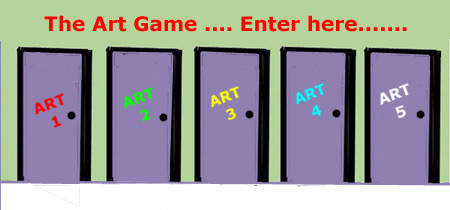
Mouse over
While the inspiration
for many of my projects has came from a wide range of sources there
are constant concerns that continue to weave through the various projects
and act as linkages.
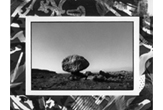
|
An
example of this is the use of the photogram.
I first used this technique for the Codes
of Survival - 1989 - project which related to physical
objects we discard into the environment. I looked to combine photographs
of the environment to photograms of various objects. It came from
an experience in the Subantarctic Islands of debris washed up
on pristine beaches. |

|
This
work led to Adze to Coda - 1992- combination prints of photograms
of various tools and landscape photographs - but presented in a
slightly different manner. |
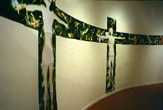
|
which
led to Evidence from the Religion
of Technology - 1983 - Large colour photograms with a life
size figurative element |
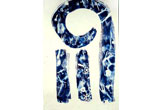
|
Then
to Aproian Emulsions - 1996 - Photograms using alternative
photographic processes where the liquid emulsion was painted
on in a free form manner as motifs and symbols - Some of this work
was incorporated alchemic
symbols |
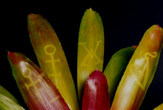
|
then
to Photo-syn-thesis - 1998 - Photosynthetic photograms on the leaves of Bromeliad plants
- where alchemical
symbols were cut from opaque tape and stuck onto the leaves
of Bromeliad
plants for up to 4 months to form a photosynthetic image. |
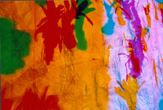
|
then
to en
LIGHT en, 1999 - an interactive projection work with Bromeliad
plants suspended in the gallery - which produced multi coloured
shadow images of the plants on tissue paper screens as various projectors
turned on and off triggered by the audience. |

|
Then
to @ the
Speed of Light - 2002 - an interactive projection work where photograms of Bromeliad
plants self-developed on sheets of photographic paper as the
exhibition progressed. |
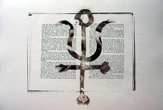
|
then
to Hermetic Emulsions - 2004 - Alternative
photographic process photograms - painted as alchemic
symbols onto pages from a book
on alchemy found at a local beach |
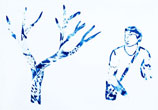 |
then
to Conversations
with Trees -2007 - Alternative photographic process photograms,
where the liquid emulsion was painted on in a figurative manner |
The instigation
can be triggered quite instantaneously – perhaps from an experience
like a walk in the bush, desert or beach, reading a book, listening
to music, looking at a movie or TV, looking at other art works, or a
dream. A chance discovery or experience might sit dormant for years
until something intervenes and acts a catalyst.
Or it might be
something which has concerned you for quite sometime and you have some
understanding of - like specific aspects of the environment. Some artists
use a mind mapping technique where they sketch down a wide range of
things they are interested in and look for connections.
Or it might extend
on from a previous project.
In terms of my alternative process work Aporian
Emulsions led into Hermetic Emulsions which then led into Conversations
with Trees. The common factor in each of these projects is
a technique - the use of alternative photographic emulsions, the use
of photograms and applying the emulsion as a form of painting. However,
there is variation in the content and the aesthetics for each series
of work.
What ever the starting
point, it is essential to chose something that you strongly identify
with – something you are passionate about – something you
can sustain an interest in for a period of time. If you are aiming to
develop the project into a succinct body of work you need to remain
fully engaged with the subject. So work on something that you have a
genuine interest in.
Mind Mapping
Some artists use a mind mapping technique where they sketch down a wide range of things they are interested in and look for connections between disparate interests in the map and possible directions. Write down all the possible interests that offer ideas, sticking down small images and drawings, and then drawing arrows that connect various aspects. This can be a valuable way to open up new directions. Look to explore the mind map on three levels, conceptual or content, aesthetic or visual and technical. |